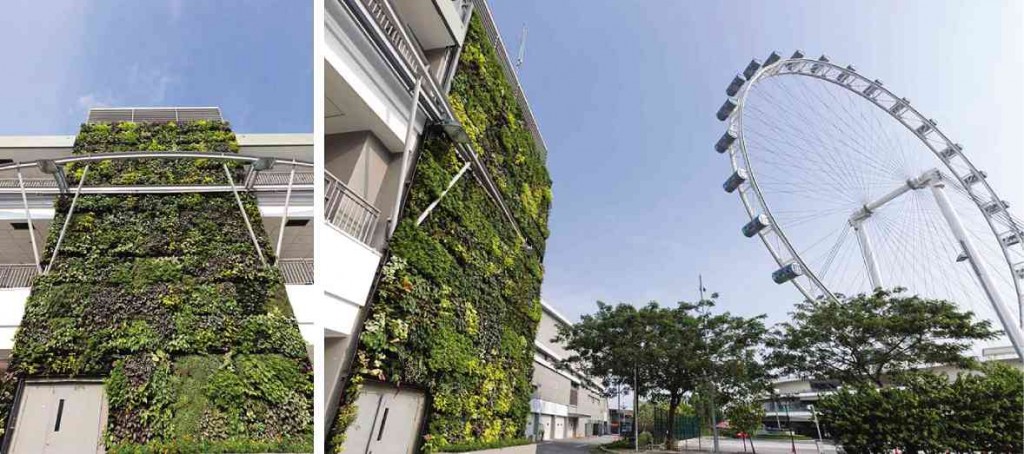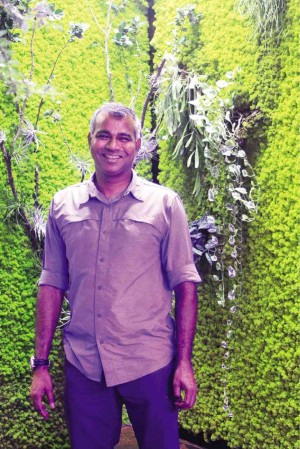At the peak of his career, botanist Veera Sekaran contracted a rare nerve condition called Parsonage-Turner Syndrome, causing both his arms to be paralyzed.
“Both my arms were not working,” Sekaran said. “[The doctors] gave me six months to live.”
Even if he was immobilized, Sekaran continued to develop his systems in vertical gardening, pursuing his vision to spread the concept of urban “green walls.”
Today, the fully recovered Sekaran is now one of the top pioneers of vertical gardening in Singapore. His company, Greenology, has been recognized in the country and in some parts of the world. He is also tagged as the “Plant Whisperer” by many.
“I firmly believe that the plants nourishes the soul and bringing plants closer to people is very important,” the Greenology founder said. “In horticulture therapy, feeling and touching plants make us feel better.”
Living tapestries
Greenology, Sekaran said, is the art and science of greening. By combining the art and science of botany, horticulture and landscape architecture, Sekaran and his team of greenologists produce living tapestries whether if it’s on a residential or a commercial project.
Through a system called Greenology Vertical Greenery (GVG), over 600 species of plants can be grown on a vertical garden over urban spaces such as roofs, building façades, walls, structures and interiors that would cause better microclimate cooling, dust, sound abatement, human well-being and aesthetics.
The GVG is a customizable framing structure that allows versatile installation to fit any shape or size, weighing only 25 kilograms per square meter and is 20 millimeters thin.
“Our GVG is the thinnest and lightest … made from aluminum panel with nanofiber. We do not use plastic as a material because it is not meant for façades, especially for green walls,” Sekaran said. “That is the concern of most clients.”
Their vertical greenery is one of the most water-efficient systems in the world. It is fully-integrated with a timer-activated irrigation and fertigation (the combined application of water and nutrients to a crop—a mix of fertilizer and irrigation).
Unlike the usual pot systems that has to be changed regularly, GVG does not attract infestation of mosquitoes.
Wall space
“GVG would also save you more on cost and space than putting on potted plants,” he said. “If you have a wall space, [probably] using up to 2 to 3 sq m, you can get about 30 to 40 plant species growing on it without having to worry about watering, maintenance, or anything else because it looks after itself.”
Sekaran believes that it makes more sense to use a wall space in condominiums as it would not cost extra on spaces.
Aside from GVG, Greenology also offers designed moss walls called Greenology Living Art (GLA). The GLA are bespoke aesthetic centerpieces ideal for indoor living spaces. A certain piece, according to Sekaran, is priced per square meter and would range from 800 to 2,000 Singaporean dollars.
In addition, Greenology also has energy-saving LED lights which are designed for optimal plant growth and are essential in low or no light environments.
Greenology’s known projects are installed in the F1 Pit Building and the Woha building in Singapore.
Urban farming
Recently, Sekaran is developing a system on urban farming that would allow growing of vegetables in a closed condition and contained ecosystem.
“Self-sufficiency has been a thing now and going vertical has a lot of benefits. But when you do urban farming, [you] would be growing your own food source,” he said. Through aquaponics, a conventional aquaculture, with hydroponics, the waste food fish like tilapia can be used for organic farming.
The idea of urban farming came in three years ago when Sekaran had a project in Africa. He wanted to help the villages grow vegetables faster to feed themselves that is why he started to research on different systems to work on it.
Still raising funds
Sekaran admitted that they were still raising funds for this kind of system. However, his nursery in Changi Village supplies vegetables to his own restaurant in the same location, the Kakis.
The company Greenology has been operating for more than six years now and has reached out to countries like Malaysia, Indonesia, Australia and the Middle East.
“I also got people coming in who are interested to do it in the Philippines,” he said. “We will probably be greening the world, one wall at a time.”



